One afternoon during lockdown I was determined to find Primrose Cottage. Even though, according to Google Maps it was only 0.1 miles away from where I live I’d failed to find it on two previous attempts. How could it possibly be so difficult to find? Well, much of the town of Hebden Bridge consists of houses that are on such steep hills that flights

of steps, often obscured by trees, connect the streets, making it difficult to see both
the houses themselves and the way of access to them. It appeared that access to
Primrose cottage was either up such a staircase, or up a steep cobbled road that
appeared to dead end in a high wall. I wound my way along the cobbles and today
my luck was in because a man was weeding the wall. “Am I close to Primrose
Cottage?” I inquired. The man pointed to a doorway at the bottom of a high three
storey wall, and there, above the door was a sign bearing the house name, decorated
with yellow primroses – of course. The man looked at me, questioning my inquiry. I
guess I didn’t look like a delivery truck driver. “An ancestor of mine used to live
here” I explained. He relaxed. “Ah, they’ll be right glad to see you, luv. Just go up
them steps round th’ back.” The steps led up to a lovely patio and sitting in the shade
of a colourful patio parasol were a couple quietly reading and enjoying the warm
afternoon sunshine. It reminded me so much of my patio in Santa Cruz where I
would often sit and read in the afternoons. The view from this patio however,
unlike mine, was expansive, taking in much of the centre of town and looking across
to the hills on the other side of the Calder Valley. I introduced myself and explained
my mission. They knew that Newton Gibson, my first cousin 4 times removed had
lived there. “But for this wretched virus we’d invite you in. Come back when it’s all
over,” they proffered.
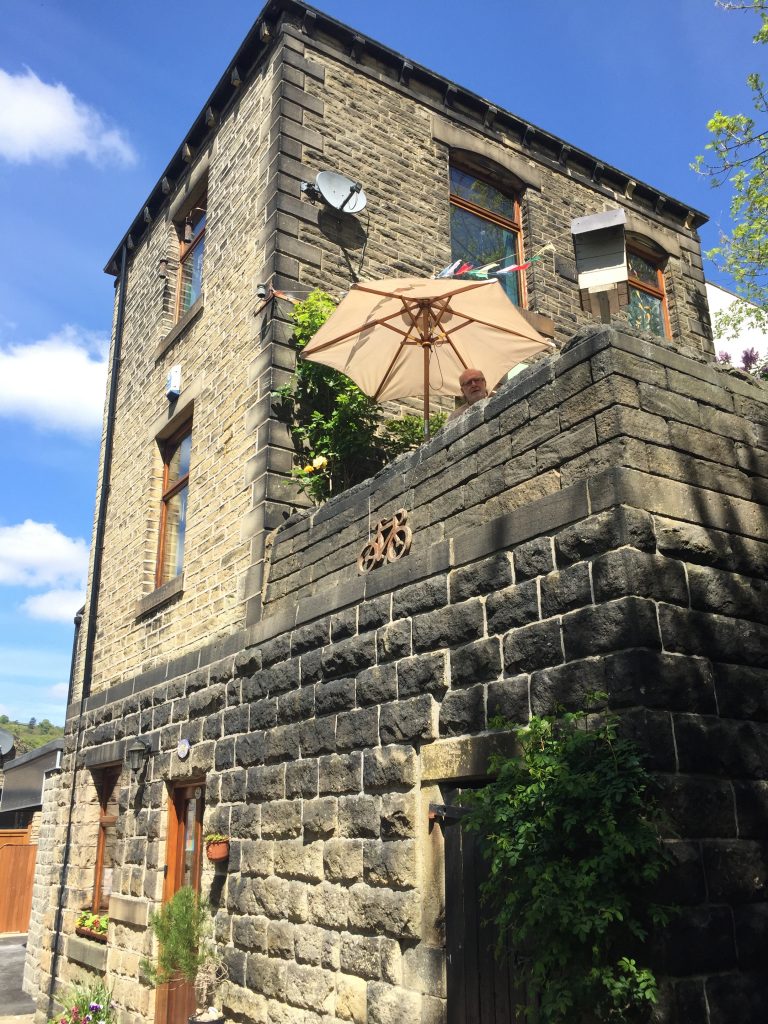
Newton Gibson, born in 1848, was the son of Thomas Gibson and Sally Wrigley.
Sally was 18 years old and living at Lily Hall in Heptonstall when she married the 19
year old Thomas. Thomas was a whitesmith, as was his father, Samuel, making small
parts for machines, a indespensable profession during this period of industrial
expansion. Newton was born in one of the cottages at Foster Mill, a large cotton
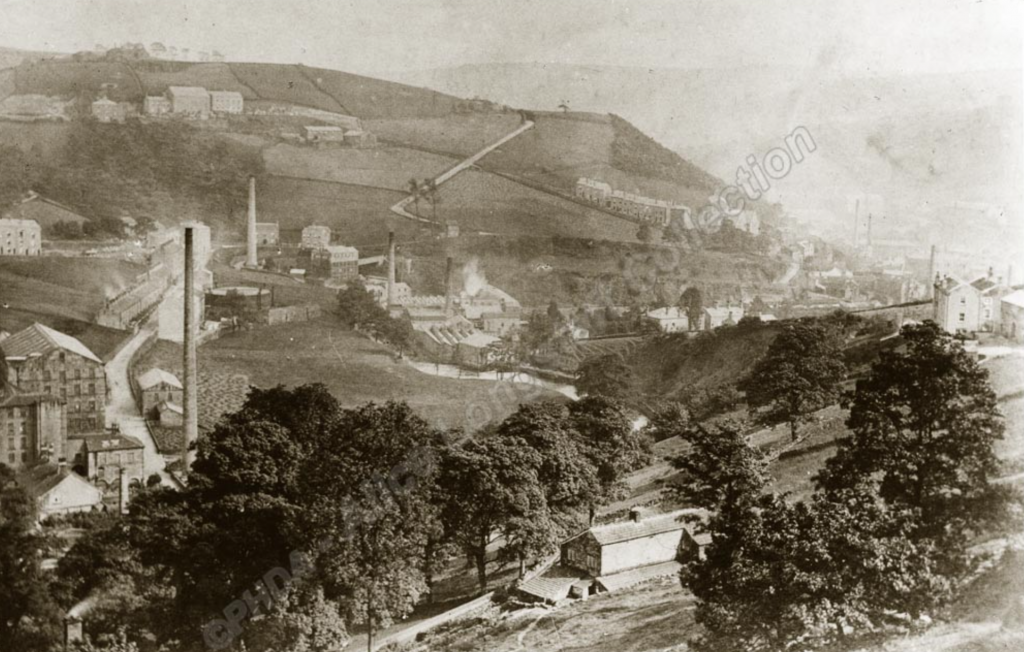
spinning mill six storeys high with 17 windows running its length where his father
was head mechanic. The mill even had its own school set up by the mill owners in
1844 but Newton received the benefit of an education at Heptonstall Grammar
School, a school with a reputation for high standards. It’s now the Heptonstall Museum where I sometimes volunteer. I’d begun my day with Newton
at the former site of Foster Mill since that’s where Newton began his life. On what
was once Foster Mill Lane new houses sit on the site of the old mill and the mill
chimney was demolished. When Anna was here in May 2018 we’d gone to
have a look at a house for sale on that very street – Spring Grove, houses on flat land
a complete rarity in Hebden Bridge. Foster mill had been worked on extensively by
my Wrigley builder ancestors. In 1842 the mill chimney had been plastered by Thos.
Jas. & Geo Wrigley for Wilm & Jas Saga – 14.5 days work. Another day when I passed
an old disused two storey building on the mill site a man was planting some
bedding plants in some waste ground. On impulse I asked if he knew if the building
had once been connected with Foster Mill. “Perhaps,” he said. “That very old building on the
left, just before the bridge was the stables for the mill.”
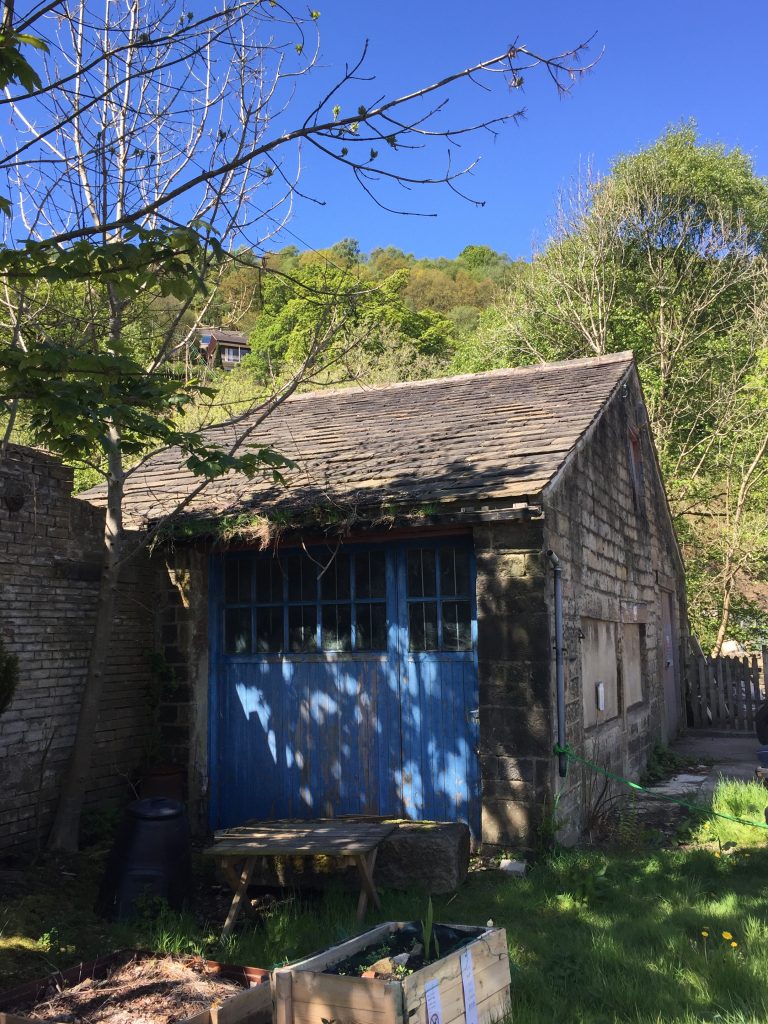
I’d taken several photos of
that building since I’d moved to the town, simply because it had some great doors
with flaking paint – one of my specialities. “There used to be a row of cottage where
we’re standing. I have a photo of them. Would you like to come in and see it?” and with that he led the way over to one of the houses on Spring Grove. The photo was
framed and on display in his living room.
At the end of the road a small hump backed bridge, retaining its cobbled pathway
leads over Hebden Water. Built in the late 1700s this was part of the packhorse
track leading up the hill to Heptonstall and it’s a path I take frequently throughout
the seasons. The bridge is smaller but simlar in construction to its more famous
counterpart in the centre of town being very very steep, narrow, cobbled and with
very low parapets. The horses that used these Pack horse bridges were laden with
bolts of woven fabric which hung from the saddles and these needed to clear the
height of the parapets.

Once over the bridge and past the ramshackled huts
scattered in the allotments by the stream all is quiet, the trees dense with leaves
now. To the right of the stream is the mill goit chanelling the water to the mill and
close by is the former mill pond. One day I was drawn to the pond’s edge by an
unusual sound, and, clambering over moss covered stones I could see dozens of
frogs floating peacefully in the water, their head just above the surface, serenading
me. The pond is part of The Delph, an area of green space and allotments,
specifically designated for the recreational use of the mill workers and their families
including hot houses complete with boilers enabling prize chrysanthemum growing.
The millpond itself, was used not simply as a vital part of the mill’s functioning to
supply the mill steam engines with water, but also by locals for fishing and picnics.
In good weather I often pass picnickers here, children paddling in the stream and
there’s even a rope swing that will allow you to fly over the water. Overlooking this
idyllic scene is Dog Bottom the house Newton’s family had moved to and where his
father set up his photography business (story in another chapter).
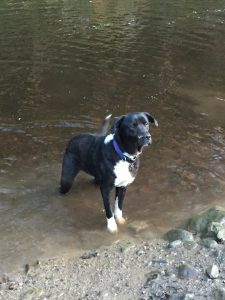
By the time he
was thirteen Newton was apprenticed to Mr Charles Warner, a watchmaker in
Hebden Bridge. He did not serve his full time as an apprentice instead joining his
brothers in the manufacture of sewing machines which the family had started fifty
years before and took great pride in being the first firm to advertise and supply
various metal parts called castings for sewing machines. Ten years later Newton and
his brothers James and Samuel were living on Crown Street, as did I when I wrote this,
and was part of a sewing machine manufacturing business . They developed the ‘Z’
type whipping machine which created blanket stitches to neatly finish the edges of
blankets. The Science Museum in London holds one of their machines.
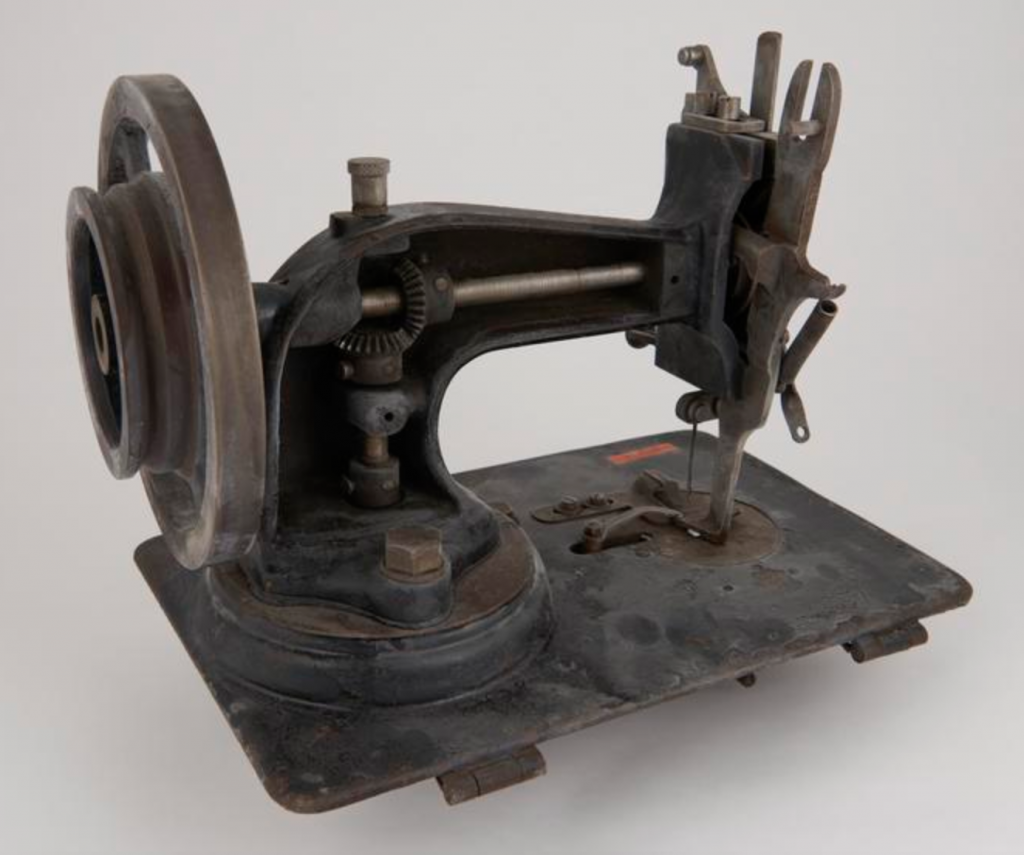
An
advertisement in the local paper in 1881reads “Gibson Bros. Sewing machines on
the Singer principle. Parties requiring sewing machines on the singer principle can
be supplied direct from The Works at considerably below the Agent’s prices.
Gibsons patent sewing machines for manufacturing purposes are the only machines
worth having as they are warranted to to double the amount of work of any other.”
Their business flourished and by the mid 1870s the family owned three houses, a
warehouse and a workshop all on Crown Street. If these buildings remain I must
pass them every day. Perhaps I can even see them from my window but I’ve not
been able to pinpoint them so far.
In 1888 Newton married Elizabeth Clegg. Surprisingly Elizabeth had not been born
in the Calder Valley. With very few exceptions almost every person in ‘my Hebden
Bridge family’ had been born, lived and died in the Calder Valley, and so it wasn’t
until lockdown that I had begun to explore another valley, that of Cliviger Gorge
which runs from Todmorden over to Burnley, following a geological fault line.
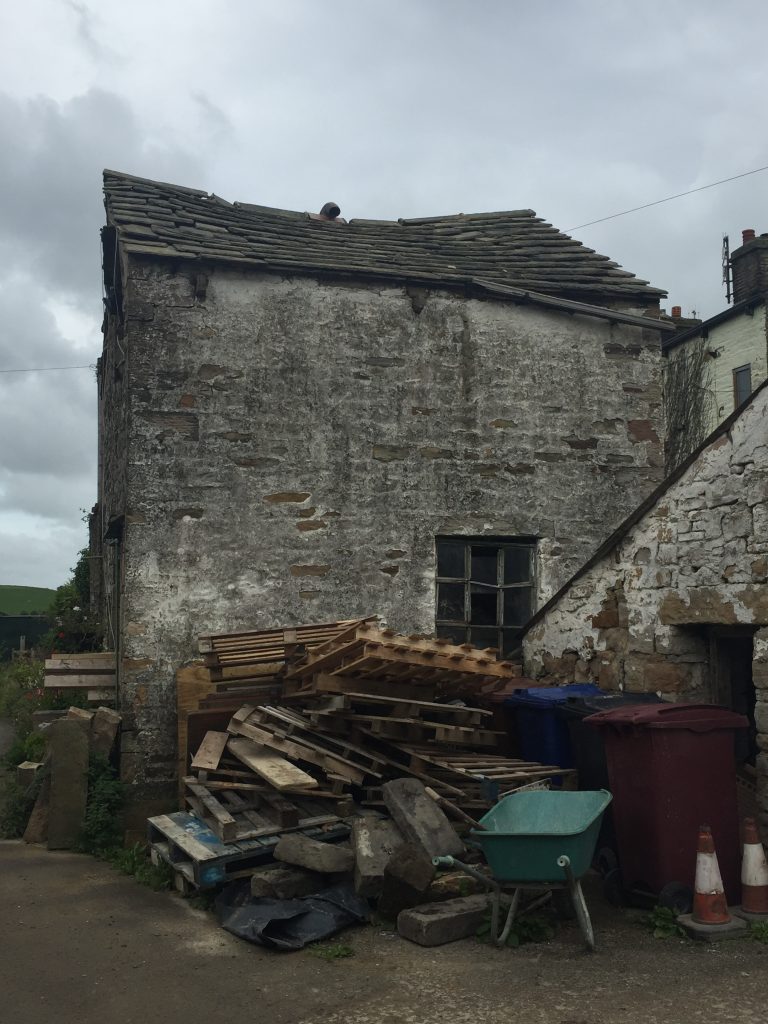
The terrain and landscape are quite different from the Calder Valley and I’d begun to
explore the small communities of Holme Chapel and Shore.
I began my day in the
small village of Holme, just over the Lancashire border, having recently read about
Holme Hall, a place dating back to 1340 when Richard de Whitacre arrived in
Cliviger. With several extensions by 1431 the building had become a manor house of
40 rooms, remaining in the Whitaker family until 1950.
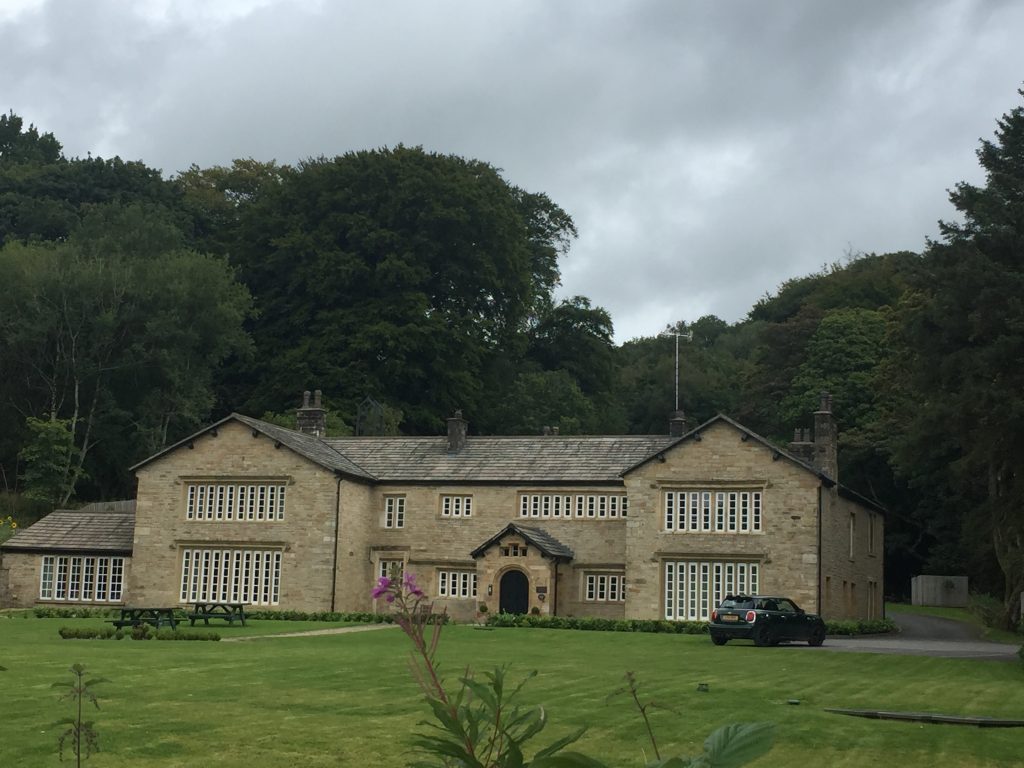
I found the building easily
enough, now converted into apartments after a devastating fire in 2003. It’s light
sandstone colour glowed in the afternoon sunlight. It still retains its stone slated
roof and mullioned windows. A gabled porch lies in the centre of the façade flanked
by two gabled wings. Then I discovered something totally unexpected. Rev
Alexander Whitaker of Holme Hall sailed with Sir John Dale in 1611 to the colony of
Virginia in Chesapeake Bay, becoming known as The Apostle of Virginia. My
goodness. From here to the U.S. (or at least what would eventually become the U. S.)
in 1611! Two years later Pocahontas, the daughter of the native American chief, was
captured and placed under Whitaker’s care where she was taught English and the
Christian religion. She was given the honorary title ‘Princess’ and it is generally
believed that this minister from Holme Hall officiated at her baptism and eventual
marriage to John Rolfe, the founder of the Virginian Tobacco Industry. Wow! The present church stands close to the site of a 16th century chantry chapel that had fallen into disrepair and had to be demolished (1788) – the present church being built upon the hill through the benefices of the Whitaker family of Holme, Cliviger, between 1888-1894, in particular Dr T. D. Whitaker, the eminent historian and antiquarian. (‘Journal of Antiquities’)

Another chapel now drew my attention. Above Holme Chapel and back in Yorkshire
is the tiny hamlet of Shore, meaning ‘steep sided valley.’ Just over 1000ft above sea
level it has a derelict church in its midst and I’d spent a wonderful afternoon in the
roofless chapel, its floor strewn with pews, the plaster moulding around the lights
still visible. I’d found an old film made in 1971 about a year in the life of this church
showing people arriving by taxi (yes, the road is REALLY steep) , singing in the
ladies’ choir, the children’s choir, the Sunday school prize giving, tea parties, the
annual coach trip.

Shore Chapel 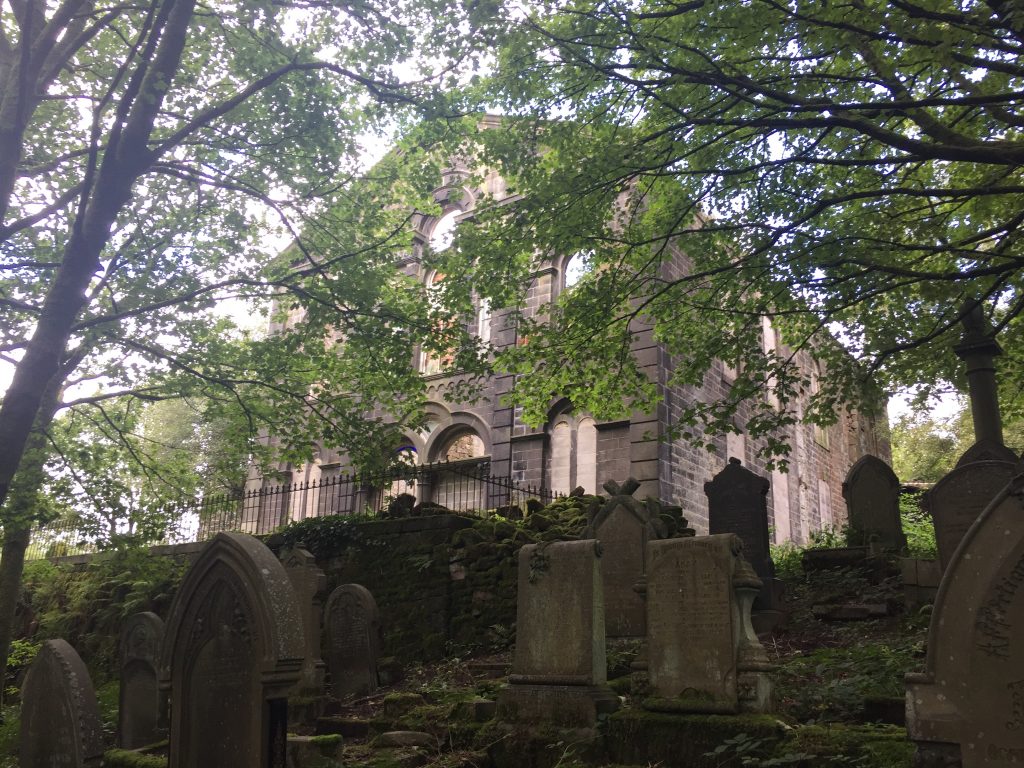
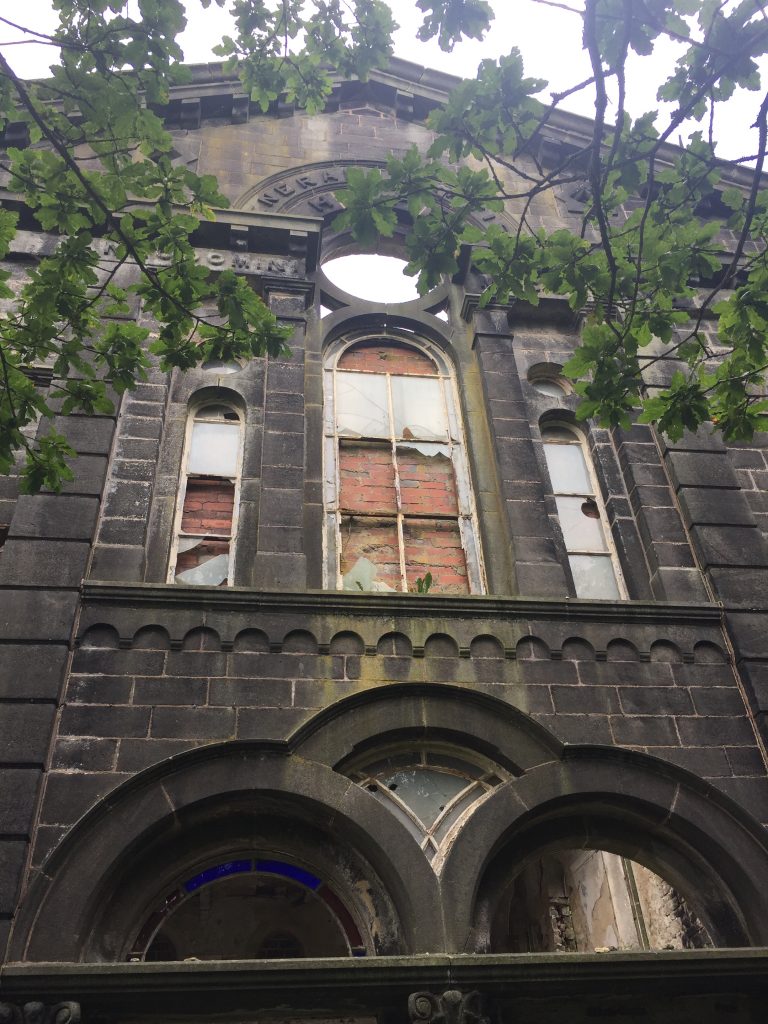
The roof of the chapel fell in years ago, after the church had been
declared unsafe because of dry rot. With a bit of prodding the wrought iron gate
opened and I was able to see inside the chapel since the front wall has gone. It’s
interesting to note how mill gates and chapel gates are so similar. Someone
had made a bonfire of their rubbish in what had once been the nave. The coving
around the light fittings could clearly be seen and the wooden planks strewn over
the floor had once been pews. I’d read about a flight of stairs at the West side of the
chapel.
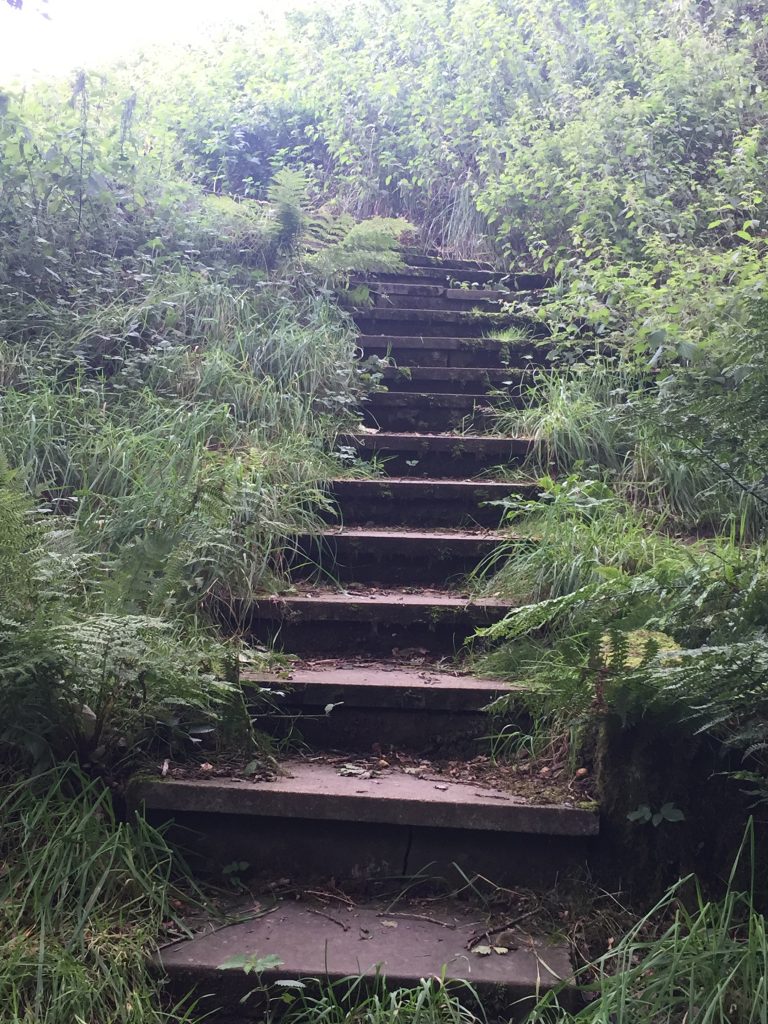
The church is perched right on the edge of the cliff and so the extensive
graveyard appears to be falling down the hillside. 122 steps with an iron rail still
present in places goes down to the Wattenstall River and, this being a Methodist
church, people went down the steps to be immersed in the River as part of their
baptism ceremony. Then they would climb back up the stairs for the service in the
church. The General baptist Repository and Missionary observer of 1865 records that “on June 10th Mr Gill baptised 41 people, 21 men, 20 women, the youngest
candidate being 15, the oldest being 77.” 126 Some baptisms took place on Christmas
Day when the ice on the stream had to be broken. It wasn’t until 1871 that the
Baptistry was installed inside the church!
Across the stream, once the hive of so much activity, is the track leading to Blue Bell
farm and this is where Elizabeth, daughter of John Clegg, a farmer, was living at the
time of her marriage to Newton at Heptonstall church in June 1888.
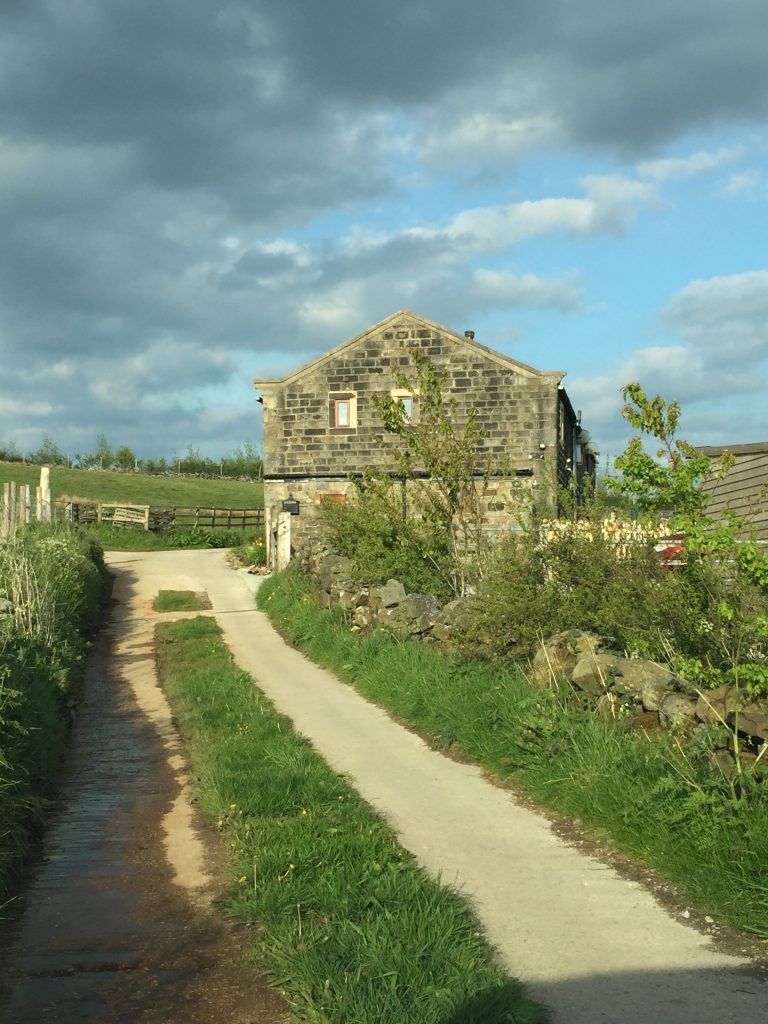
I had noticed a stone datestone on the wall at Primrose Cottage. Yes, 1888. So I presume Newton
had the house built for him and his new bride. Perhaps he knew that Elizabeth was
used to having a good view from her parlour above Shore and he wanted to give her
something comparable. Newton and Elizabeth lived at Primrose Cottage for the rest
of their lives and it was there that their only child, Samuel, was born in 1894.
That
Newton develped an interest in photography is not surprsing. His father had started
off life as a whitesmith but by the time he was 42 he gave his profession as
photographer. While never becoming a professional photographer Newton was a
prolific photographer and painter. Unlike other members of his family he was of a
retiring disposition and took no part in public affairs. His obituary states “He will
not be remembered primarily as a business man but it was in his pursuits in his
spare time that he gained most recognition. With watercolours and oils he was a
painter of no little skill. He created cartoons and sketches of a particularly heated
election in the town, but it is as a photographer that he excelled, having some photos
hung in both the Royal Photographic Society and the Academy of Photography in
London. His “candle light” pictures found their way into journals in France,
Germany, Austria, Italy and America. Many of these are now reproduced on
postcards. He excelled in ‘table top photography’ too, that is the creating of outdoor
landscapes on a table. Mountains were made of crumpled paper, for snow fine sugar
was used. He often got good water scenes by placing the models on a sheet of tin
which reflected the models realistically. The horses, cows, sheep, cats and dogs were
simply wooden images. He and his brothers were the first to travel about the district
showing their images by a magic lantern.’ Several of his glass lantern slides are held
in the Hebden Bridge Local History Society Archive. He was president of the the
photographic section of Hebden Bridge Literary and Scientific Society of which I am
a member and during lockdown I received acclaim for a photo that I’d entered into
the society’s annual contest. The prize was to have the photo printed and be shown in
the exhibition to be held at the town hall. But on the day of the opening a national
lockdown for Covid was announced and the exhibtion is awaiting rescheduling.
Perhaps Newton’s most famous photograph is ‘Angel over Hebden Bridge.’

I’d seen this
photograph during my research into the Gibson photographers but it wasn’t until I
was standing on the patio at Primrose Cottage overlooking the town that I realised
the photo had been taken from this very spot. The distictive former cooperative
building can be seen with its diagonal doorway. Looking over the town is an angel
with outstretched arm, as if in blessing. I don’t know the date of the photograph but
in Victorian times, as today, audiences were fascinated by visual special effects.
Skilful projectionists using specially designed lantern slides were able to create the
illusion of movement or gradually transform a Winter scene into a Summer one or
day into night. The devices used to achieve this could be simple, such as one piece of
glass with a painted picture on it moving in front of another or very complex slides
with levers, pulleys and rack and pinion mechanisms. The slides shown are known
as ‘dissolving views’. This might not sound wildly exciting now but when first
introduced in the 1820s it was magical and mysterious. In 1881 an evening’s
entertainment of dissolving views of Egypt that Newton gave was the talk of the
town. “A very successful exhibition of dissolving views took place in the upper room
of St. Thomas’s School on Saturday evening last by Mr. Newton Gibson, of Crown-
street, Hebden Bridge. The views were chiefly of places in Egypt, These were
followed by scenes of local interest. Views of the interior of St. Thomas’s Church,
Heptonstall and of St. James’s, Hebden Bridge especially delighted the audience. The
proceeds (which amount to a handsome sum) will be devoted towards defraying the
expense recently incurred in providing the Sunday Schools with new seats and other
requisites.”
Like his grandfather, after whom he was named, he had a desire for natural history
and was fond of literature being a particular admirer of Shakespeare with whose
entire series of plays he was thoroughly familiar.
Newton died in 1915 and I wondered if ‘Angel over Hebden Bridge’ which appears
to be a ‘contact print’ – made of two negatives sandwiched together – is perhaps a
symbol for wishing safety for the town and its inhabitants during the the first war.
It may seem strange today to think of Hebden Bridge participating in World War l
but it certainly played its part. Newspapers of the day carry obituaries of the town’s
young men, killed in battle. In the town itself men who were involved in essential
service industries could apply for exemption from ‘signing up.’ On Aug 4 1916
Hebden Bridge local military tribunal considered 80 applications for exemptions
ranging from poultry farmers to one Ernest James Sowden of Crown Street who
claimed to be ‘indispensable for shoeing horses.’ Greenwood Pickles, a fish and
potato frier, likewise a plumber and sanitary enginner and a watch, clock and
jewelry maker all applied for exemption as key workers in their local community.
Some were refused. Newton’s nephew, Edward Binney Gibson, a surgeon/dentist
claimed that since 1908 his work load had doubled and his father, Thomas, with
whom he ran the business in Croft Terrace, could no longer manage without him,
and that the business would have to close completely if he was not made exempt. He
was given a temporary expemption, likewise John Willie Horsfall, a hairdresser on
Bridgegate. Samuel Gibson, Newton’s only child, was given exemption for 3 months
in August 1916 as head of the firm of Gibson Bros. But the following year he was
summond to appear at Todmorden court and for not answering his telephone. But
this was no ordinary call. This was a test call in case of air raids etc. “At 12.05
midnight on the 20 th inst the firm were rung up and did not answer, whereas they
were bound to do so within 15 seconds. Two more rings were given without getting
a reply. Defendant pleaded that he took reasonable precaution and left a manager in
charge who declared that he never heard the bell ring. The Bench characterized the
offense as a very serious one, and fined the defendant 40s and 5s witness fee.”
Newton’s high standing in the Hebden Bridge community was aptly illustrated in his
extensive obituary in the local newspaper after his death May 1915. Following a
service at Primrose cottage Newton’s own car was used as the hearse and headed up
the steep hill to Heptonstall church, followed by ten coaches. Employees of Gibson
Brothers acted as bearers and amidst the numerous wreaths was one from the
photographic section of Literary and Scientific society.
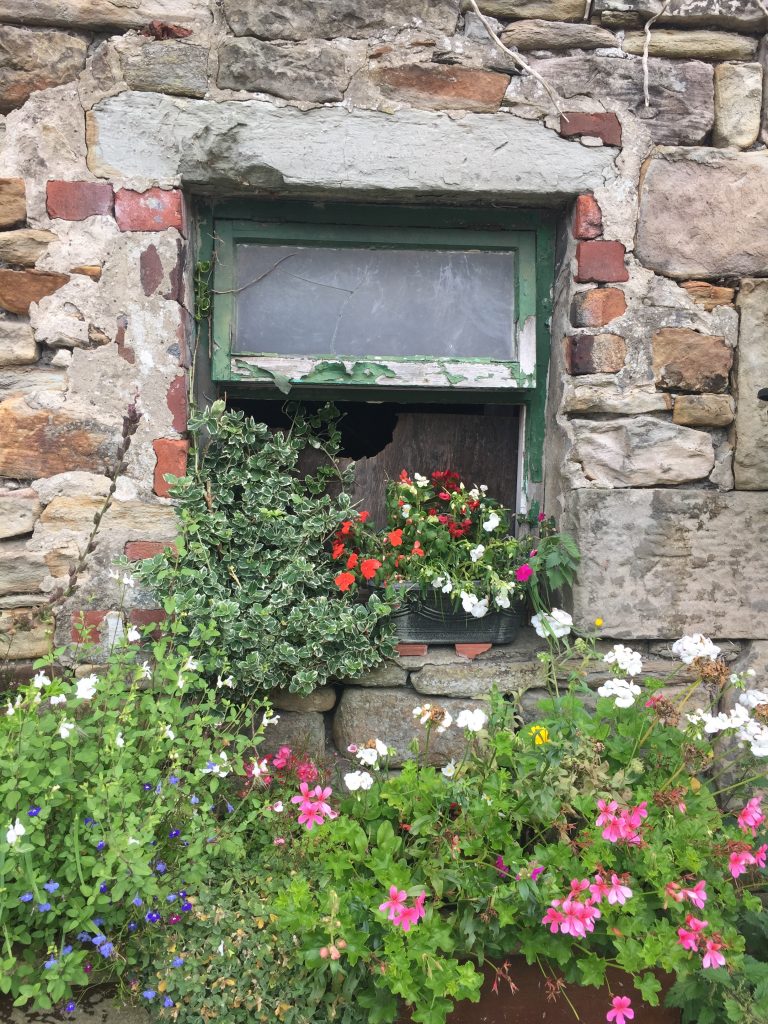

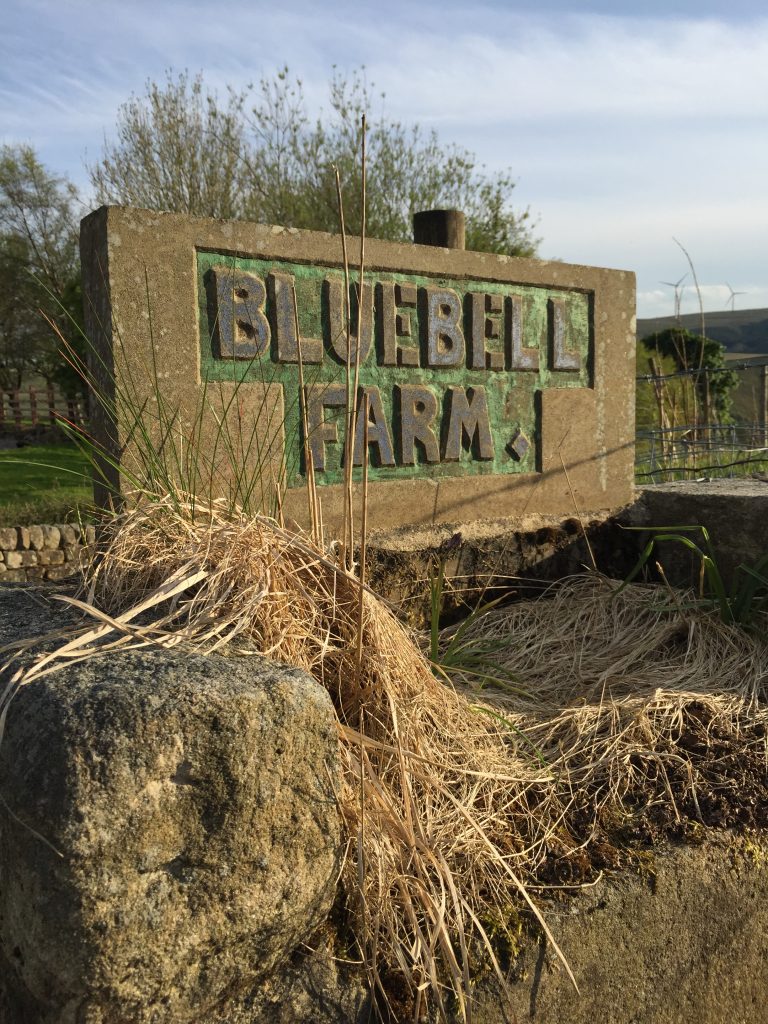

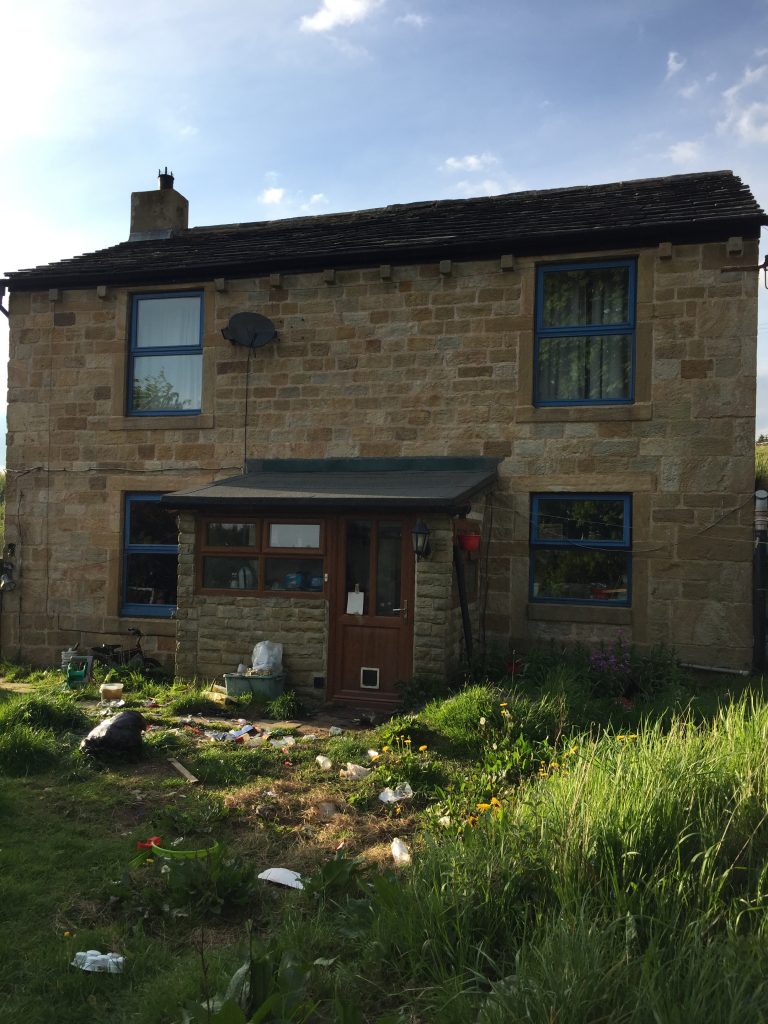
Leave a Reply